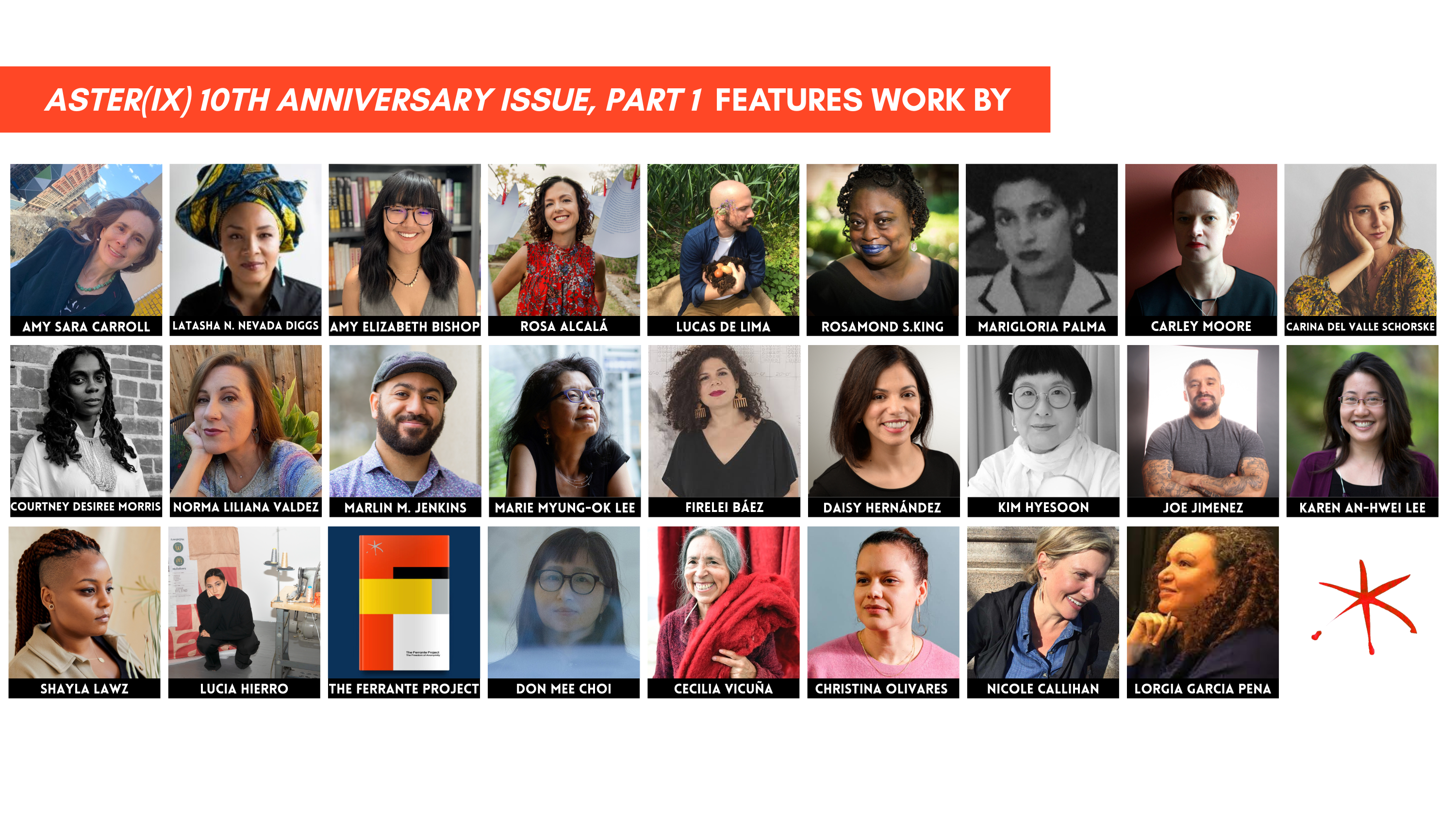
We are thrilled to share our Spring 2023 release, The 10th Anniversary Issue Part I: Poetry & Nonfiction. Aster(ix) is a laboratory, a space where women writers of color can play and experiment. We celebrate our 10th anniversary with a double best-of issue; Fall 2023 will feature Fiction and Interviews.
Please see below for a conversation with the editors and the table of contents featuring all pieces.
AVAILABLE NOW IN PRINT:
book shop | amazon | barnes & noble
All of the pieces are available to read online for free below. The print issue features new reflections from contributors on their pieces as they share what inspired the piece and what it means to them now.
Conversation with the Co-Editors, Angie Cruz & Marta Lucía Vargas
Angie Cruz (AC): Thank you for co-editing this issue with me. I can’t believe we’re celebrating the 10th year anniversary of Aster(ix) Journal. Remember that moment when we started the journal? We were on the phone: Nelly Rosario, Sheila Maldonado, Adriana Ramirez, Emily Raboteau, you and me. We were brainstorming the name for the journal and why we thought this project was important. The VIDA count had been released validating what we already knew, how women and BIPOC writers were underrepresented in mainstream literary spaces. That was the moment when we asked the question: why aren’t we publishing what we love? And that night we named the journal. We were thinking about omissions and one of us asked, How about the word asterisk? Then Sheila who was studying Mayan symbols suggested “ix” And I think it was you who offered the parenthesis.
Marta Lucía Vargas (MLV): I remember we were bringing in indigenous intelligence of what becomes language, and how language can be obliterated. How it can be massacred. And invented. So we were inventing. We were inventing our own language by creating this title that tried to capture everyone’s essence. That was the beauty of it. A collaborative effort. It was a virtual platform to disseminate writing across the country, among us. The works that live in our printed issues and online are now scattered all over the world for love, for play, for art. We were creating a virtual republic for ourselves where we could gather and continue conversations. When I think of these ten years, I think, what does it mean to cumplir? It means to come through, to achieve. So this is 10 years of a project that has been realized. To cumplir is to be realized.
AC: Which is not that different from what we tried to do with WILL: Women in Literature & Letters back in 1997. We made a call for women of color writers to gather, read and write with us. We were thinking about the transformational possibility of literature. In the past ten years do you have some moments that you felt were particular to Aster(ix) where you understood the importance of the journal?
MLV: Big Question. I loved coming up with the title. It was like being in a birth. And then when our masthead of contributing editors and board members came together at Blue Mountain Center Retreat in 2016 to think and forward the agenda. That was a powerful experience for me. We discussed the online presence, the book presence, the actual objects that make up the journal and how we’re trying to do different things. And people were coming up with different projects. A lot of things grew and were born there. That time was a great example of how we come together and we imagine ourselves into being. The essence of the work has always been what we love. And what we love could be content related. It could be context related. The root of it is how we allow our imaginations to run wild and free and turn them into something, take action.

AC: Which is really tied to the mission, right? I love how Aster(ix) has emerged into a laboratory, a space where we could play and experiment. It began with the naming of it, but also in the ways that we invite writers and artists to participate in play. The most exciting issues for me were the ones where we invited others to try something they wouldn’t have otherwise unless we had made the invitation. I think of the Ferrante Project, where writers wrote anonymously. I think about the issue that you edited with Saretta Morgan and when we invited Jenlle Troxell to reimagine the modernist practice of the boudoir. Jenelle reminded us that we were part of a long tradition of literary magazines that were created by women with commitments to publish works on the margins. So Aster(ix) is part of a long literary tradition going back to the modernist era with Jane Heap, and Margaret Anderson, where they rented out their apartment to fund The Little Review.
MLV: What happens when we feel safe and trusting in the unknown? Let us jump into the unknown and say what the fuck, let’s just do it. Yeah, it doesn’t matter whether it’s in your apartment or at Blue Mountain, or by the edge of the water. It’s this permission to be free. And recreate the center. We are the center, we are not the margin. Toni Morrison really described her life’s work as recreating the center. It was a conscious decision to stand at the edge and make it the center.
How can we bring new life to the work we love?
AC: Yes, Morrison said, “I stood at the border. I stood at the edge and claimed it as central. I let the rest of the world move over to where I was.” That quote embodies what we’ve been doing. Like the ways we continue to question language used in the realm of literary journals. Like what does it mean to “submit” work? Why do people have to submit? What is submission? Why not center an invitation to a conversation? Why are so many editors invested in claiming to discover someone? It’s so colonialist! Why do we have to be the first to publish someone, why not reprint work? How can we bring new life to the work we love? We continue to have these conversations while editing together. Some of my favorite moments in our ten years have been when we edited together. When we were in cafes, reading poems closely and being in conversations about the line, line breaks, word choices. Not a lot of writers get that attentive editorial advice or guidance. But what’s exciting for me is how we have become closer as a collective when we think through what we love and when we ask questions about the work.
MLV: The work is the play, play is the work. For my mother who was always moving, reading felt like being idle for her. If I’m reading, I’m available to move. I really didn’t know this my entire life, my body knew it. So that’s why I hid under the covers or in the library for hours. It was the protection of that action. When we grow up, we’re among people who want to gather and do the things we used to do in the secret world. It’s a secret society of work because no one is inviting us to do it anyway. But we have that urgency to do it and it’s so powerful. It’s overpowering. And we don’t have a choice but to do it. And that’s kind of cool.
AC: The truth is we’re under no institutional obligation to meet deadlines for Aster(ix) and we often have to ask ourselves, why do we continue to do it. All of us have such demanding lives outside of Aster(ix) taking care of our children, elders, our writing, jobs to pay the rent, and yet when summoned we stay up at night pulling these issues together. So I ask you, what does it mean to continue to do this work? What compels you to continue to be part of this familia?

MLV: I remember being a naysayer of us back and saying, why are we doing this? Let’s save some trees or some electricity. Do we have to do this? Should we just do our own work? And yes, yes, and yes. But it’s powerful coming back together. The idea of coming together and nurturing each other to go wild. We are creating something that is necessary. It’s not required by an institution, but it’s required by our inner landscapes.
AC: I do think that even the diversity, aesthetics, walks of life, positionality, of who has been influencing where the journal goes does create a vitality to the work. Why do I continue doing the work? Every time I think about quitting, I get an idea of another issue or project. So I guess I will continue because I am still inspired by it. I’m also grateful that we have a vehicle to put the ideas to work. For example, the “In Residence” column on our website where we invited writers to respond to the lost painting, “Amaranta” by Cecilia Vicuna. The writers we invited to participate were so thankful for the prompt. For some it broke their writer’s block or allowed them to flex a new genre. So what excites me is to see what happens when we invite someone to play and then see what they do.
Why do I continue doing the work?
Every time I think about quitting,
I get an idea of another issue or project.
MLV: This constant experimentation allows for a different kind of journal. It’s an amazing thing when we’re working on an issue and people are traveling, taking planes across the country and saying “what are we going to make together here?” And sometimes, we don’t know. And that’s okay. And that’s acceptable. So, it’s pretty radical, in the way that it’s atypical in its methodology and anti-capitalist. In terms of timeframe, deadlines. Even when our fluidity may receive pushback.
AC: Historically, it has not always been easy to prioritize wellness over deadlines and product. I believe that’s what makes this largely volunteer run effort sustainable– the ways that we offer flexibility to do the work without pressure. Because if we would have put pressure on ourselves, I think a lot of us would have quit. I see the journal as a conversation with you and everyone on the board that is always emergent. The works are also in conversation with each other. This is why I’ve always loved the ways Aster(ix) reprints old work, because when you reprint something old and bring it with something new, it becomes part of the new conversation and you can read it in a totally new way.
* * *
Marta Lucía Vargas and Angie Cruz met in 1996 in Taxco, Mexico and soon after co-founded WILL Women and Literature & Letter, with Adelina Anthony. WILL was a grassroots effort (1997-2001) with a vision to gather women from all over the world who believed in the transformative powers of reading and writing. Many of the writers who participated in WILL are now contributors and a part of the Aster(ix) masthead. In 2013, Adriana Ramirez co-founded Aster(ix) Journal with Angie Cruz with a commitment to pick up where WILL left off and create a home for what we love, without explanation or apology.

10th Anniversary Part I: Poetry & Nonfiction
Table of Contents
- “Untitled & Ze” by Amy Sara Carroll | Poetry
Originally published in our Fall 2016 issue, What We Love - “How To Search for Your Child” by Norma Liliana Valdez | Poetry
Originally published in our Fall 2017 issue, Dirty Laundry - “Calling Collect from Prison/Father-Daughter Intermediary” by Amy Elizabeth Bishop | Poetry
Originally published in our Spring 2016 issue, Atravesando - “Sequence from Botanic América” by Christina Olivares | Poetry
Originally published in our Winter 2019-2020 issue, The Poetry Issue - “What the Ground Remembers” by Courtney Desiree Morris | Nonfiction
Originally published in our Spring 2014 issue, Ra(i)ces: Black Feminist Encounters - “Seasonal Affective Disorder” by Marie Myung-Ok Lee | Nonfiction
Originally published in our Fall 2022 issue, Mothers Unearthed - “Firelei Báez on Generosity and Freedom in Art” by Angie Cruz with Firelei Báez | Conversation
Originally published in July 2017 online at asterixjournal.com - “Reparations” by Rosamond S.King | Poetry
Originally published in January 2017 online at asterixjournal.com - “This Moment of Mine/Este Momento Mío” by Marigloria Palma, translated by Carina del Valle Schorske | Poetry
Originally published in our Fall 2017 issue, Dirty Laundry - “On Eschatological Radio Angels Flying In The Troposphere” by Karen An-Hwei Lee | Poetry
Originally published in our Fall 2016 issue, What We Love - “Chance Encounter” by Cecilia Vicuña, translated by Rosa Alcalá | Poetry
Originally published in our Summer 2017 issue, Kitchen Table Translation - “Topping From The Bottom” by Amy Sara Carroll | Conversation
Originally published in May 2018 online at asterixjournal.com - “Rodillas: A Kind of Reckoning” by Daisy Hernández | Nonfiction
Originally published in February 2018 online at asterixjournal.com - “Mediocrity is the Space Waiting to be Filled by Eccentricity” by Lucia Hierro | Poetry/Art
Originally published in January 2017 online at asterixjournal.com - “The Patient Records” by The Ferrante Project | Nonfiction
Originally published in our Fall 2020 issue, The Ferrante Project - “March” by Shayla Lawz | Poetry
Originally published in our Fall 2018 issue, Edges - “I will carry a knife and always it in my mouth” by LaTasha N. Nevada Diggs | Poetry
Originally published in our Spring 2014 issue, Ra(i)ces: Black Feminist Encounters - “Non-Essential Knowledge: Latinx Studies in Times of Covid-19” by Lorgia Garcia Pena | Nonfiction
Originally published in May 2020 online at asterixjournal.com - “list of things to say instead of ‘I’m fine’” by Marlin M. Jenkins | Poetry
Originally published in our Fall 2016 issue, What We Love - “Tlaquaches” by Joe Jimenez | Nonfiction
Originally published in our Fall 2017 issue, Dirty Laundry - “Pinto” by Lucas de Lima | Poetry
Originally published in our Fall 2018 issue, Edges - “Soft Bodies” by Nicole Callihan | Poetry
Originally published in our Fall 2018 issue, Edges - “My Big Gay Essay” by Carley Moore | Nonfiction
Originally published in June 2018 online at asterixjournal.com
Selected for BEST OF THE NET - “Death of a Family” by The Ferrante Project | Nonfiction
Originally published in our Fall 2020 issue, The Ferrante Project - “A Lullaby” by Kim Hyesoon, translated by Don Mee Choi | Poetry
Originally published in our Summer 2017 issue, Kitchen Table Translation - “You to the Future” by Rosa Alcalá | Poetry
Originally published in our Fall 2018 issue, Edges
Masthead for the Aster(ix) 10th Anniversary Issue Part 1: Poetry & Nonfiction, co-edited by Angie Cruz & Marta Lucía Vargas
- Editor-in-Chief/Founder • Angie Cruz
- Publisher/Founder • Adriana E. Ramírez
- Managing Editors • Amanda Tien & Megan Valley
- Senior Fiction Editor • Tanya Shirazi
- Contributing Editors for The 10th Anniversary Issues • Laura Kenney, Sangi Lama, Sandra Lee, Paola Liendo, Avery Robinson, Kandala Singh, Kira Witkin
- Aster(ix) Contributing Editors • Rosa Alcalá, Arielle Greenberg, Yona Harvey, Daisy Hernández, J. A. Howard, Sheila Maldonado, Dawn Lundy Martin, Oindrila Mukherjee, Idra Novey, Emily Raboteau, Nelly Rosario, Zohra Saed, Sun Yung Shin, Jenelle Troxell, Chika Unigwe, Marta Lucía Vargas, Autumn Womack, Elleni Centime Zeleke
- Advisory Editors • Ari Ariel, Armando Garcia, Amy Sara Carroll, Norma Cantú, Xochi Candalaria, Jennifer Clement, Edwidge Danticat, Cristina García, Stephanie Elizondo Griest, Andrea Thome, Helena Maria Viramontes








